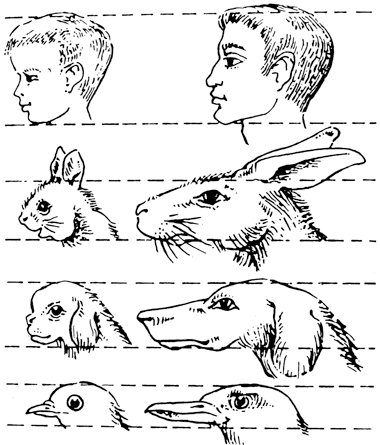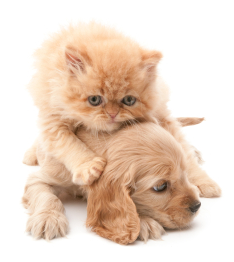mailbagletterYour book mentioned cuteness and made me wonder.
July 1, 2022

image | above
This graphic shows the facial features of juvenile mammals — compared to adult mammals. These body features: big eyes, pug nose, round face, short limbs, pudgy belly, tiny mouth, soft or downy hair, and tumbling like a toddler — are always associated with infants.
In the fields of zoology + psychology, these baby body features are called “innate releasers.” Because when adult humans or animals see a baby trait, it triggers parental care-taking instincts such as: feeding, bathing, monitoring, warming, and general protectiveness.
— contents —
~ dialogue
~ reading
— letter —
Dear Ray,
Your book on creating intelligence mentioned cuteness — and it made me wonder: why are most baby animals so cute? The naked mole rat is a possible exception. If cuteness is not an exclusively human concept, its origins must be way back in time — so cuteness is possibly common to all mammals?
Newborn birds in a nest are not cute. Even baby fish aren’t too cute — but they do have big eyes. How do humans + animals recognize cuteness?
— Howard
— letter —
Dear Howard,
I have to agree with you that baby naked mole rats are an acquired taste, in terms of cuteness.
All mammals have a mind, so they must have some brain-based ability to appreciate the visual appeal of their young offspring. But it’s probably the case that baby rats are cuter to their parents than to humans.
— Ray
— reading —
broadcast: NPR
tag line: —
web: home ~ channel
story title: Agreed, baby pandas are cute — but why?
read | story
| “Agreed, baby pandas are cute but why?”
— excerpt —
“The big eyes in their black sockets, the round face, the pug nose, the way giant pandas tumble about like toddlers. There is considerable evidence that these things are what are known as innate releasers to our parenting instincts, says Dr. Coons, a New York University psychologist.
“In 2005, The Washington Post asked Stephan Hamann, a psychology professor at Emory University, to explain why humans think certain animals are cute. Hamann conducted studies using functional magnetic resonance imaging (fMRI) to measure tiny changes in brain activity.
“His studies found that cute pictures cause increased activity in the middle area of the orbital frontal cortex, located behind the bridge of the nose, and in the amygdala, the emotion-control center of the brain responsible for fear and arousal.
“According to Hamann, increased activity in the middle orbital cortex is usually associated with pleasure and positive emotion. Some evidence suggests the brain activity there is greater when the stimulus is neotenous, which is to say it has juvenile characteristics — a button nose, big eyes, a large wobbly head, chubby extremities or pudgy cheeks.
“Many researchers have concluded that cuteness, or baby schema, is an evolutionary adaptation that triggers nurturing responses from adults — allowing survival of the cutest, in Darwinian terms.”
related reading:
Wikipedia | biophilia hypothesis
excerpt | The biophilia hypothesis includes human preferences toward things in nature, which, while refined through experience and culture, are hypothetically the product of biological evolution. For example, adult mammals (especially humans) are generally attracted to baby mammal faces and find them appealing across species.
The large eyes and small features of any young mammal face are far more appealing than those of the mature adults. The biophilia hypothesis suggests that the positive emotional response that adult mammals have toward baby mammals across species helps increase the survival rates of all mammals.
related reading:
Wikipedia | cuteness
excerpt | Cuteness is a subjective term describing a type of attractiveness commonly associated with youth and appearance, as well as a scientific concept and analytical model in ethology, first introduced by Konrad Lorenz. Lorenz proposed the concept of baby schema (Kindchenschema), a set of facial and body features, that make a creature appear “cute” and activate (“release”) in others the motivation to care for it.
Cuteness may be ascribed to people as well as things that are regarded as attractive or charming. Konrad Lorenz suggests “caretaking behavior and affective orientation” towards infants as an innate mechanism, triggered by cute characteristics such as “chubby cheeks” and large eyes.
Tech Insider | Why do we feel the need to care for things that are cute, like puppies and kittens? Austrian biologist Konrad Lorenz came up with his “kinderschema” or child scheme, which is a list of physical characteristics that define what we consider cute. He observed that cute animals share these same traits with babies, which accesses human’s nurturing and protective instincts. There’s even a name for this: Neotony.
producer | Rob Ludacer



